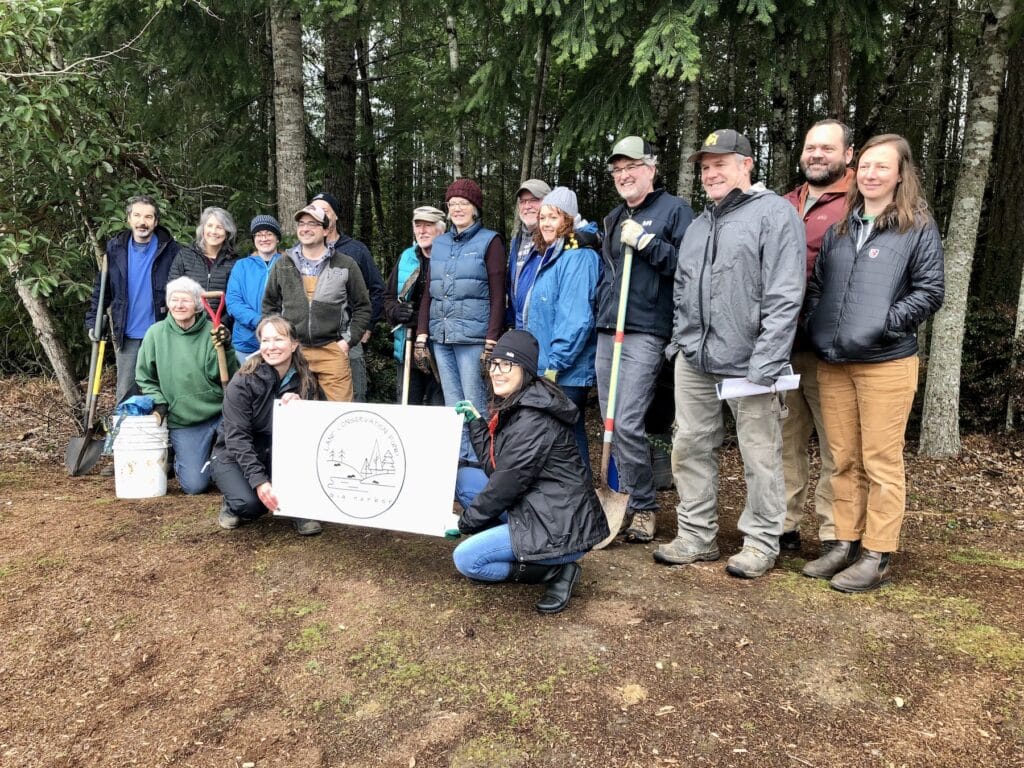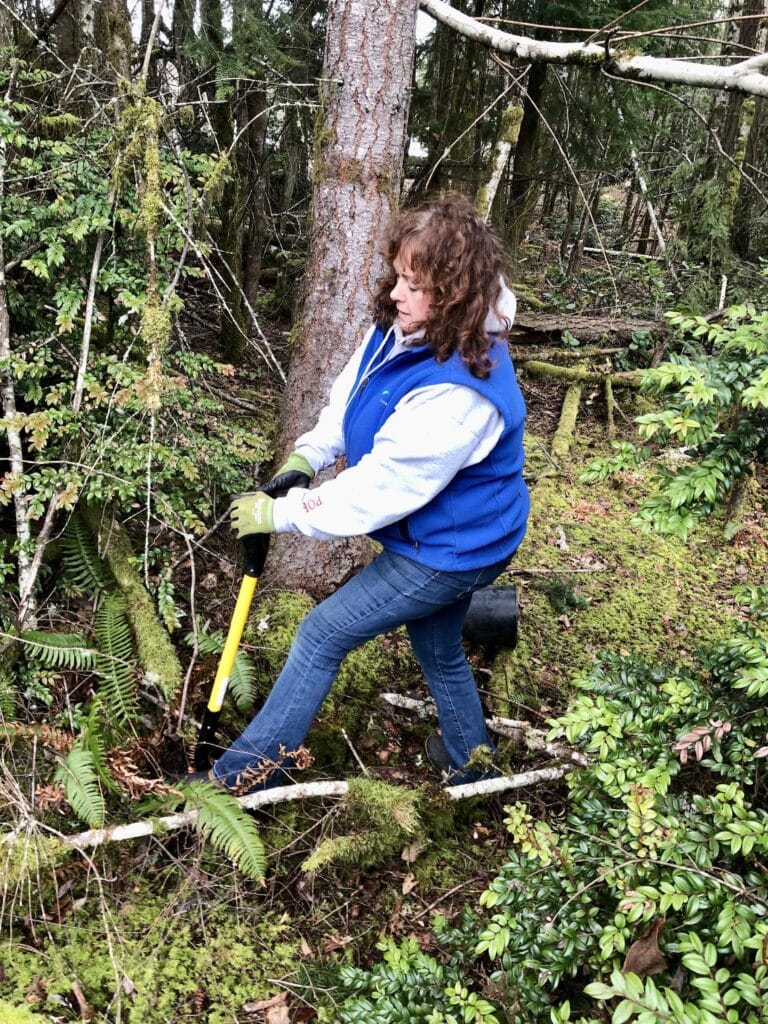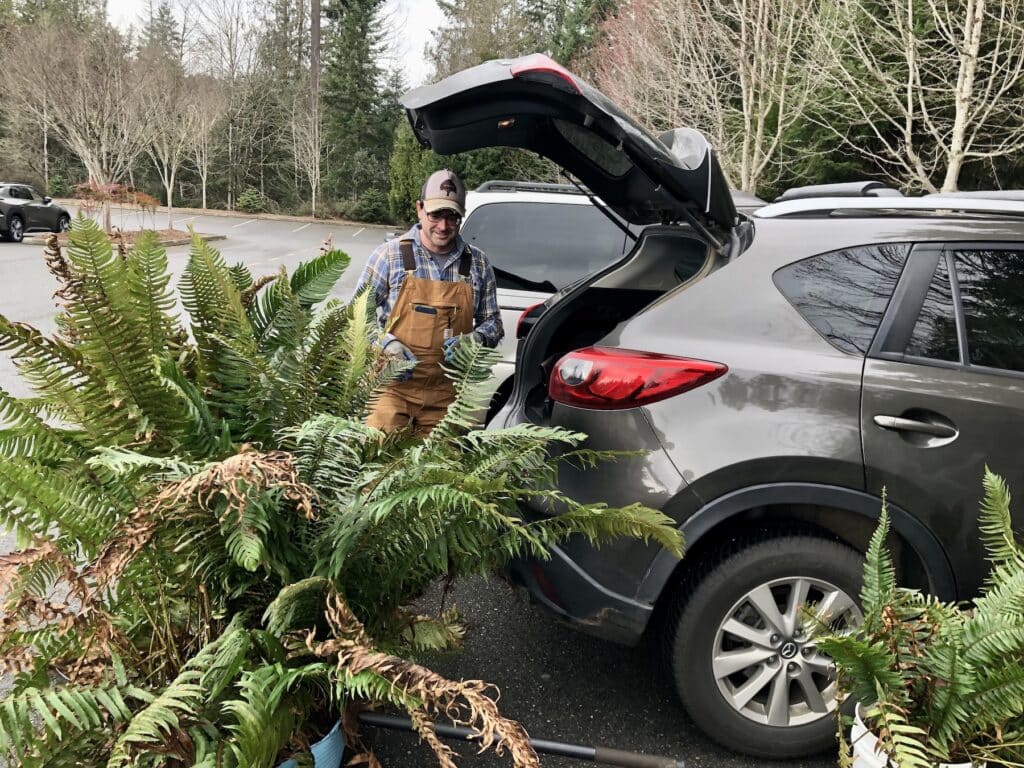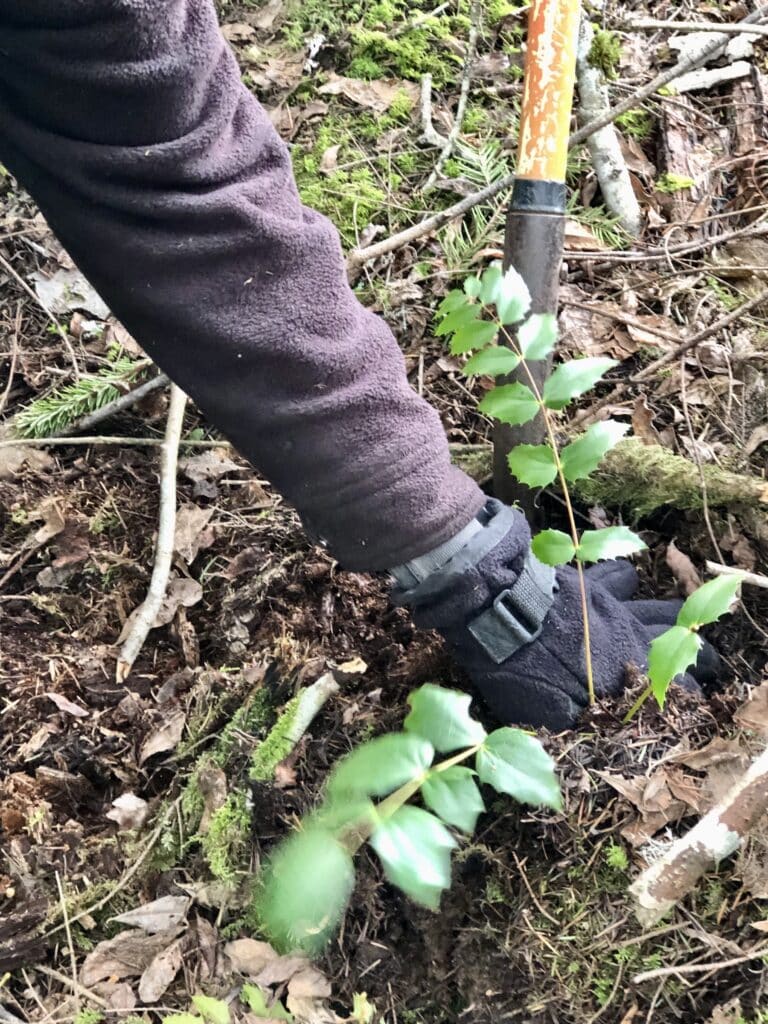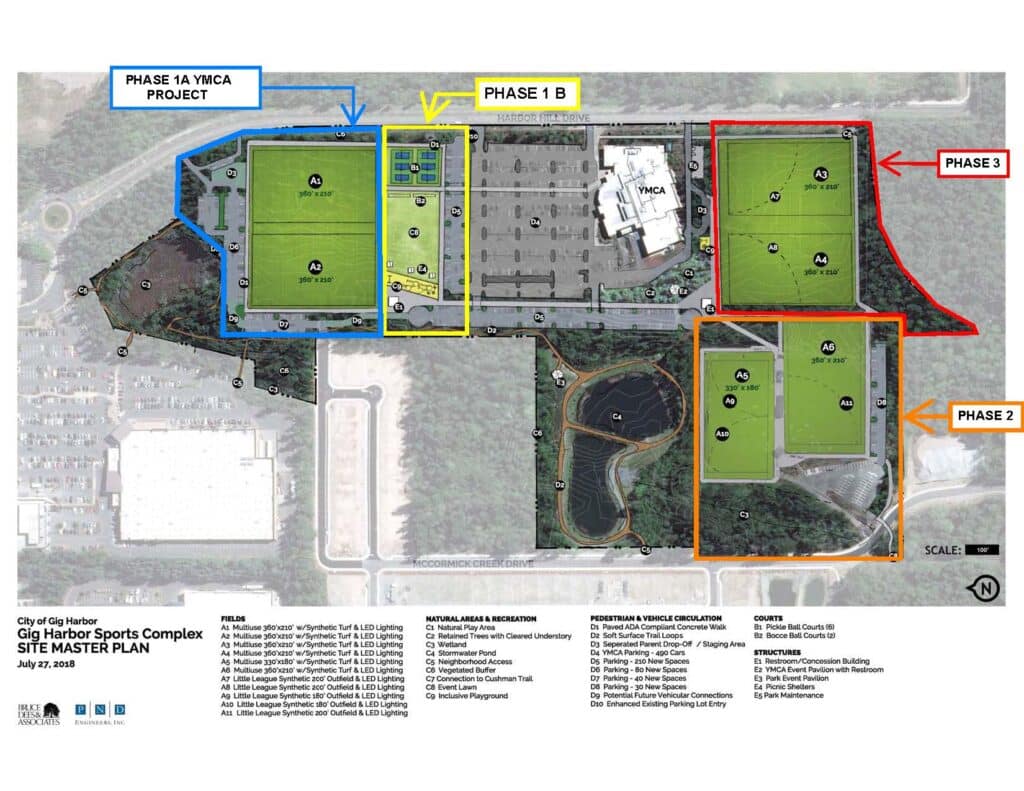Community Environment Government
Salvagers beat bulldozers to native plants
Conservation enthusiasts dug up plants Saturday morning in a forest that will soon be cleared for a portion of the Gig Harbor Sports Complex.
Phase 1B — which will include three bocce ball courts, six pickleball courts, two playgrounds, an event lawn with a covered stage, two picnic shelters and a restroom/concessions building — is out to bid. They close on March 21. The city expects construction to begin in mid to late spring, said Parks Manager Jennifer Haro.
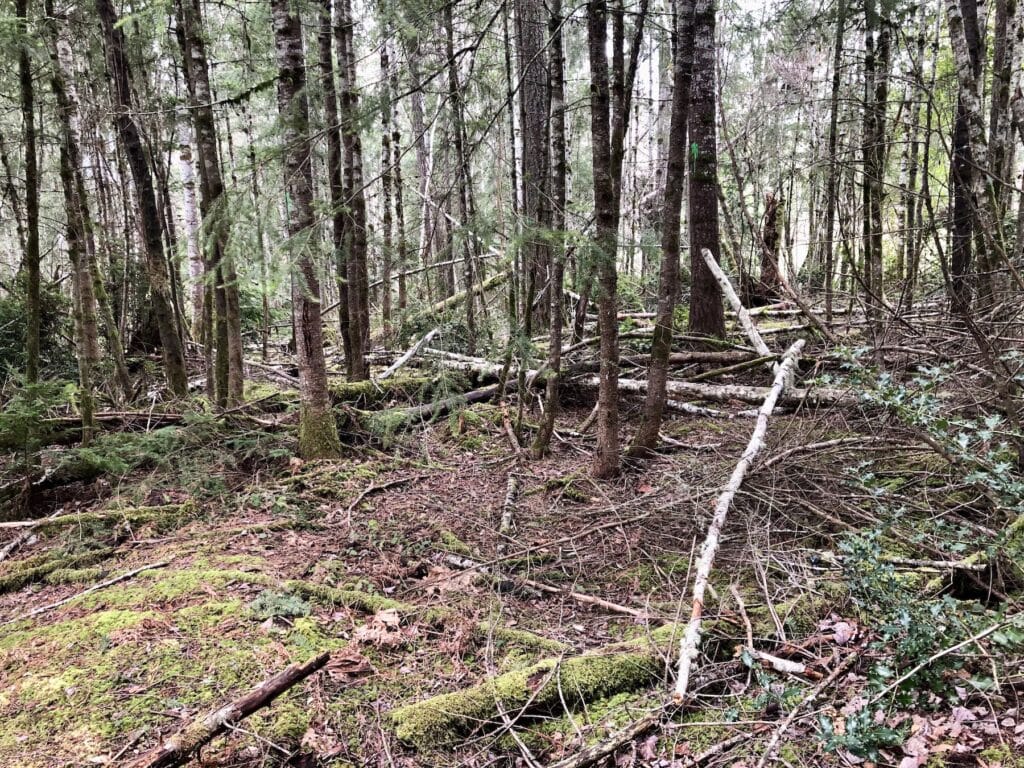
The forest north of the YMCA parking lot is mostly younger Douglas fir trees with little undergrowth. Photo by Ed Friedrich
Before logging trucks and bulldozers arrive, however, the city invited a couple dozen supporters of the Gig Harbor Land Conservation Fund to save all the flora they could in two hours. Only the 3.4-acre parcel for Phase 1B will initially be cleared. However, the Tom Taylor Family YMCA allowed digging on adjacent land where it intends to build two lighted, artificially turfed soccer/football/lacrosse fields. It continues to raise funds for that endeavor, which is Phase 1A.
It’s been done before
Harbor WildWatch sparked the idea when it asked to save sea life before the building of a commercial fishing homeport at Ancich Waterfront Park, said Pierce County Councilwoman Robyn Denson, a land conservation fund co-founder and advisory board member. The city allowed a similar plant salvage before construction of St. Anthony Hospital, Haro said.
“We reached out to the city and they thought it was a great idea,” said Denson, a former city councilwoman. “We’re doing our best to re-home as many plants as possible.”
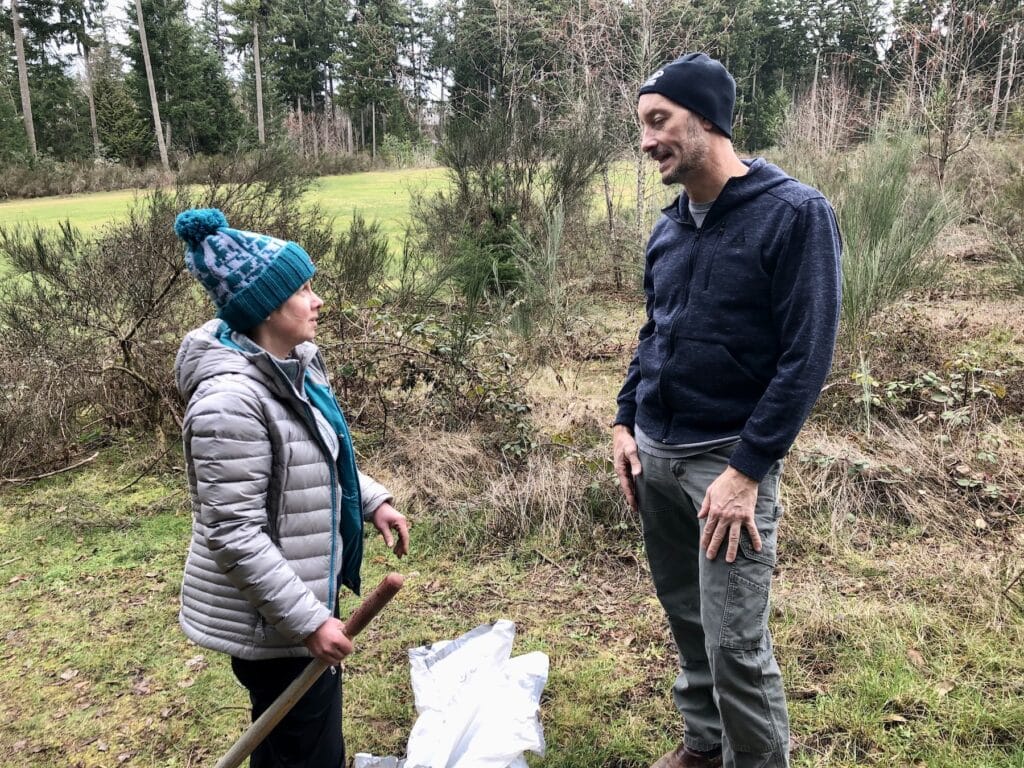
Pacific Lutheran University biology professor Michael Behrens helps Jaime Hughes-Crosbie identify her plants. Behrens is on the Gig Harbor Land Conservation Fund board. Photo by Ed Friedrich
The city took it a step further. This week, workers will follow with machinery and excavate more and larger plants to place at the new operations center off Skansie Drive and around storm ponds.
“We’re not going to save everything, but we’re going to take a lot,” Haro said.
Plants growing beneath firs
The 3.4 acres for Phase 1B is directly north of the YMCA, beside its parking lot. The forest comprises mostly Douglas fir that form a canopy thick enough to prevent light from stimulating undergrowth. Mossy, downed trees criss-cross the floor. Ubiquitous evergreen huckleberries, Western sword ferns, salal and Oregon grapes flourish along the edges where they find sunlight.
The Phase 1A parcel continues north from 1B to Costco. About one-third of it, on the west side, was already cleared. It’s grassy and home to invasive Scotch broom and Himalayan blackberries. Both properties front on Harbor Hill Drive.
Michael Behrens, a Pacific Lutheran University biology professor and land fund board member, instructed participants on which plants to gather and to avoid. He said smaller specimens fare better, particularly when salvagers capture most of the roots and accompanying soil. He recommended potting them through the summer so they get enough water and establish themselves before transplanting.
Why not save them?
“It just makes sense if they’re going to clear out everything and people are landscaping with native plants,” he said of the salvage. “This is a great opportunity.”
Several participants are replacing all or parts of their lawns with indigenous plants. Some planned to offer them at their organization’s native plant sales.
They disappeared into the dark woods, toting buckets, pots and shovels. Out they returned adorned with leaves, fronds and branches.
Sean Ludden, an ecological restoration practitioner, looked like a camouflaged special forces soldier, fern fronds protruding from his head and shoulders. He crammed the plants into his Mazda hatchback and went back for more.
Cindy Dillon, a member of the Washington Native Plant Society, stuffed black huckleberries, a red huckleberry and sword ferns into the back of her silver Volvo.
Replacing lawns
“My backyard is grass — bad grass — and I want to convert it to native plants,” she said. Dillon said her group has salvaged plants for a long time and holds a native plant sale.
Tony DeMarco needed some ferns to finish off a hillside he’d been planting.
“I’m just after things deer don’t eat,” he said. “They took all my good stuff. I’ve got to get things they don’t like now.”
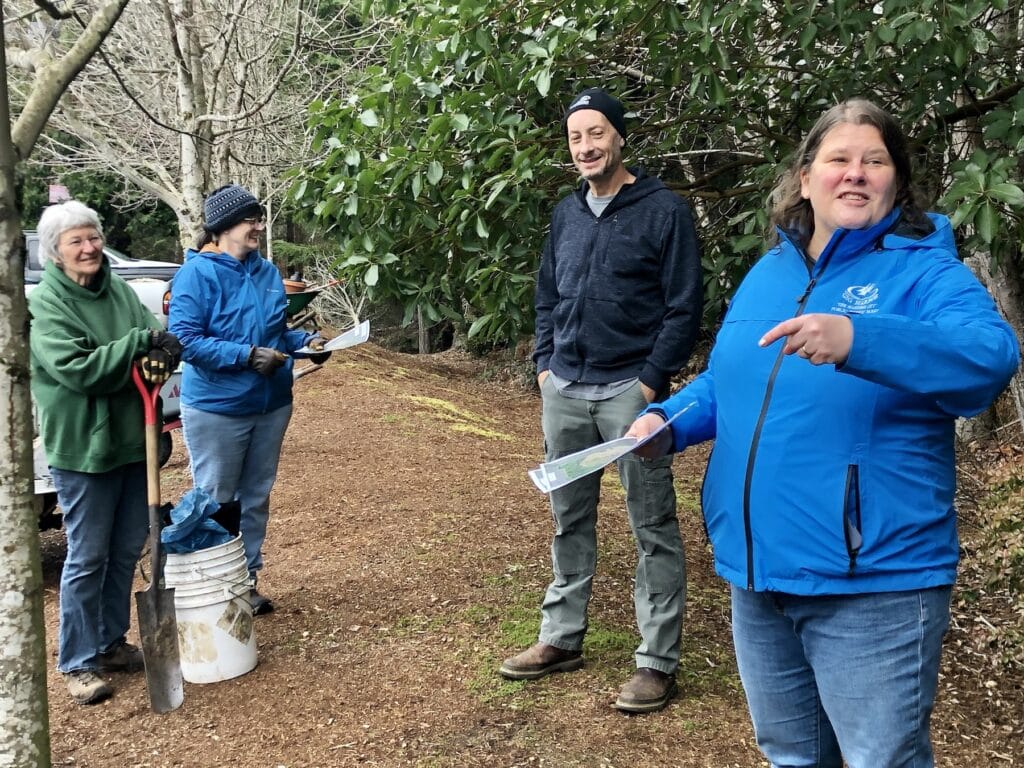
City Parks Manager Jennifer Haro directs the group on where it can dig while Michael Behrens waits to give tips on what to dig.
English ivy overtook Mary O’Brien’s place. She yanked it out and is replacing it with native plants.
“We thought we didn’t have any wildlife because of our dogs,” she said, carrying a bucket of ferns to add to huckleberry and salal she’d already planted. “Actually, we didn’t have anything they wanted.”
C.J. and Teresa Casson plan to replace their grass with natives, plant a greenbelt for a neighbor and donate plants to the Pierce County Master Gardeners‘ annual sale.
John McMillan said his wife, Mary Manning, is in charge of Masonic Lodge’s nature garden. The group has a monthly plant swap. He keeps part of his four acres in conservancy and keeps heading further in that direction.
“I’m going to go natural,” he said. “The bees need the flowers.”
Too early for spring arrivals
Participants unearthed a few uncommon species Saturday. A few had their eyes on a manzanita shrub that proved to be too large. Dogwood and vine maple trees are bare and hard to distinguish. Showier spring arrivers like trilliums and bleeding hearts have yet to break ground.
Behrens found a licorice fern. They grow in moss on tree trunks and were an important medicinal plant for Native Americans who used them as a remedy against colds, coughs and sore throats.
“Here’s my real fern geekiness, the one I am most excited about,” he said as he scraped clean the underground part of the stem with his fingernail and handed it over. “Your tongue will probably go numb. I probably should have warned you about that ahead of time.”
It tasted sweet, a little like licorice, and the tongue retained its feeling.
Council could adopt Phase 2-3 study tonight
The City Council will consider whether to adopt the final draft of the Phase 2 and 3 feasibility study at its regular meeting today, March 11, at 5:30 p.m. The study contains preferred field configurations. It is online at the Sports Complex webpage. Those who would like to comment can attend the meeting at Gig Harbor Civic Center or email the mayor and city council members at [email protected].
Adopting the study does not obligate the city to fund or build those phases in a certain timeline.
Phase 2 is redeveloping baseball fields on 9.1 acres the city acquired in 2017 and is leasing to Gig Harbor Little League. The fields would be turfed and lined for multi-sport use. Phase 3 involves developing 7.1 acres of forest south of the YMCA with two lighted, turfed soccer/football/lacrosse fields. The fields also could be configured for baseball/softball.

